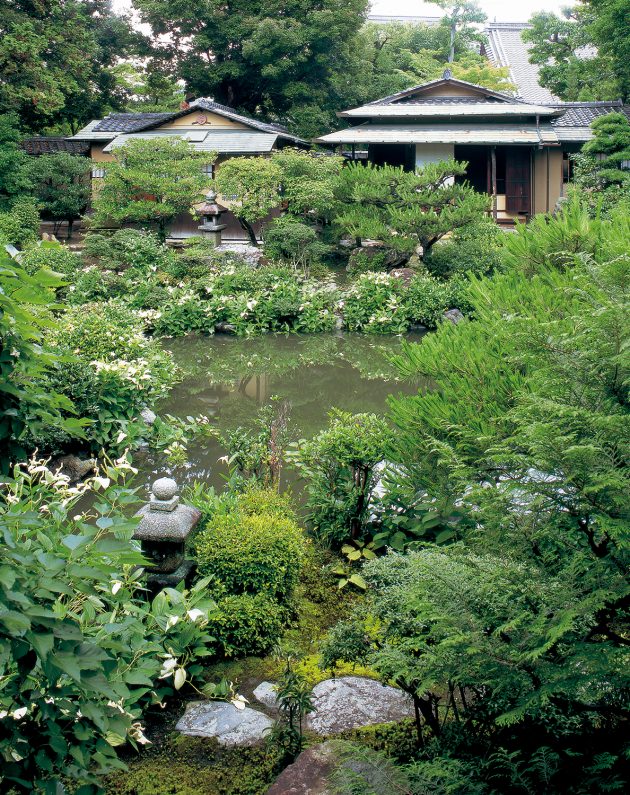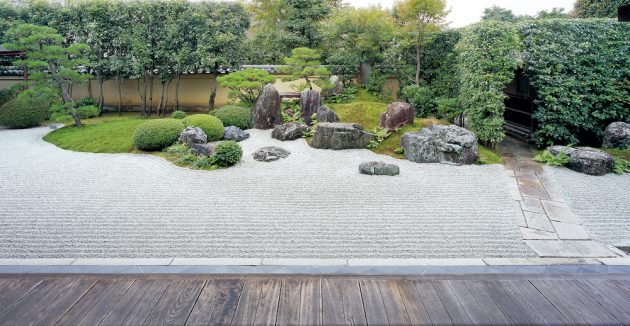
The Hidden Gardens of Kyoto, photographs by Mizuno Katsuhiko with text by Ono Masaaki, Kodansha International, Tokyo, 2004, 128pp.
As canals are to Venice, gardens are to Kyoto, even if mostly concealed behind the walls of private residences, or within sub-temples that have not transformed themselves into tourist attractions. Plenty of gardens are accessible in Kyoto, enough to keep any aficionado busy throughout the year, but one can’t help wondering what gems of garden art still remain hidden away from public view in this historic city.
Rare glimpses of some of these treasures are provided by The Hidden Gardens of Kyoto, an English edition of Kyoto hizo no niwa, a collection of color photographs of Kyoto’s private gardens by photographer Mizuno Katsuhiko. Mizuno should be designated a “Living Treasure” by his hometown, since he has been photographing Kyoto’s gardens and landscapes since 1969, and has some 110 books to his credit. Mizuno’s sublime images have done a great deal to deepen the appreciation and awareness of Japanese gardens in Kyoto, and one wonders whether there’s any place within the city limits he has not photographed.


For the most part, this gorgeous volume allows us just one peek — one photo — per garden. Mizuno’s large-format images are perfectly exposed and crisply render every crimson leaf or crown of moss. Subdued light, and rocks and moss that have just been moistened, bring out deep rich colors. An essay by Ono Masaaki, “Appreciation of a Japanese Garden,” gives a brief overview of the types of gardens and their elements. Leafing through the book, one is amazed by the imaginative variations on such a simple theme: sand, water, moss, rock, and vegetation.
The “hidden” gardens are divided into three sections: Palaces, Tea Schools, Shrines, Temples, Villas, Inns, and Restaurants. Are there any surprises?
Yes. I never imagined there was such a huge landscape garden at Fushimi Inari Shrine, and the karesansui at Tokai-an must be the most minimalist garden in Japan: plants, moss, water and stones have all been done away with in favor of an austere rectangle of raked white gravel. On the other hand, many art students are familiar with the grey pebble beach on the south shore of the pond of the Sento Gosho garden because it appears in nearly every text on Japanese art because of its beautiful placement and proportion.
Many temples were built on Kyoto’s former outskirts, where the basin rises into the surrounding hills, east, west and north. They used the forests of these hills as natural extensions of their gardens, making them appear larger, and blurring the border between what was natural and what was constructed. Good examples are the pond gardens at Nanzen-in and Honen-in. This device is similar to shakkei, the “borrowed scenery” employed by gardens in the temples of Tenryuji and Entsuji, where distant mountains are incorporated into the garden’s composition. Mizuno’s image of the garden at Honen-in is taken from the forest, looking back at the hojo (abbot’s residence), its interior illuminated to reveal its painted fusuma, featuring an abstract work by modern painter Domoto Insho. One feels as if one had just emerged from a forest to find a warm and inviting cottage-like residence. This reversal of view is refreshing and allows one to encounter the temple from a very different perspective.
This book provides yet another good reason why the prefectural and municipal governments should establish an international center for Japanese garden study and research within Kyoto. At present, the best places to study this landscape art are at universities abroad.
It should be noted that not all private gardens are impossible to visit. Sometimes all that is necessary is a phone call and a sincere interest.

John Einarsen is Kyoto Journal’s founding editor, and publisher. As a well-known Kyoto photographer, he is the author of The Forest Within the Gate (with poet Edith Shiffert) and Zen Gardens and Temples of Kyoto: A Guide to Kyoto’s Most Important Sites (with John Dougill) — and KJ’s Small Buildings in Kyoto series. He also teaches Miksang photography.